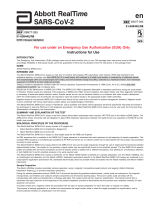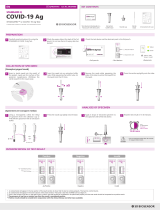
6
Specificity
A total of 5277 fresh serum specimens and 7082 fresh plasma
specimens from volunteer whole blood donors were collected at 3
distinct blood centers. A total of 3167 specimens from
plasmapheresis donors were collected at one additional blood center.
Both the initial and repeat reactive rates for the serum specimens
were 0.11% (6/5277), both the initial and repeat reactive rates for the
plasma specimens were 0.11% (8/7082), and both the initial and
repeat reactive rates for the plasmapheresis donor specimens were
0.19% (6/3167). Repeatedly reactive specimens were further tested
using an HCV qualitative RNA assay and an FDA-approved
immunoassay for anti-HCV. Based on supplemental test results for
the repeatedly reactive specimens, 14 specimens were positive, and
6 specimens were negative.
Specificity based on assumed zero prevalence of antibody to HCV in
whole blood and plasmapheresis donors was estimated in this study
to be 99.96% (15 506/15 512) with a 95% confidence interval of
99.92% to 99.99%.
Number
Positive by
IR RR Supplemental Specificity
Specimen Number (% of Total) (% of Total) Testing (%)a
Category Tested (95% CI) (95% CI) (% of RR) (95% CI)
Volunteer Blood 5277 6 6 3 99.94
Donors - Serum (0.11) (0.11) (50.00) (5271/5274)
(0.04 - 0.25) (0.04 - 0.25) (99.83 - 99.99)
Volunteer Blood 7082 8 8 6 99.97
Donors (0.11) (0.11) (75.00) (7074/7076)
- Plasma (0.05 - 0.22) (0.05 - 0.22) (99.90 - 100.00)
Total Volunteer 12 359 14 14 9 99.96
Blood Donors (0.11) (0.11) (64.29) (12 345/12 350)
(0.06 - 0.19) (0.06 - 0.19) (99.91 - 99.99)
Plasmapheresis 3167 6 6 5 99.97
Donors (0.19) (0.19) (83.33) (3161/3162)
(0.07 - 0.41) (0.07 - 0.41) (99.82 - 100.00)
Total Donors 15 526 20 20 14 99.96
(0.13) (0.13) (70.00) (15 506/15 512)
(0.08 - 0.20) (0.08 - 0.20) (99.92 - 99.99)
CI = Confidence Interval; IR = Initially Reactive; RR = Repeatedly
Reactive
a Based on supplemental test results for the 20 repeatedly reactive
specimens, 14 specimens were positive (3 blood donor serum, 6
blood donor plasma, and 5 plasmapheresis donor specimens), and 6
specimens were negative (3 blood donor serum, 2 blood donor
plasma, and 1 plasmapheresis donor specimens); all 14 repeatedly
reactive specimens found to be positive by supplemental testing were
excluded from the specificity calculations.
For total donors, the IR rate not reactive on retest was estimated to
be 0.00% (0/15 506) with a 95% confidence interval of 0.00% to
0.08%.
IR Rate Not Reactive on Retest = 100% × (Number of IR – Number
of RR) / (Number Tested – Number of RR)
Sensitivity
A total of 807 specimens from the categories shown in the table
below were tested using the Alinity s Anti-HCV II assay at 3 clinical
sites. Repeatedly reactive specimens from individuals at increased
risk of HCV infection were tested using an HCV qualitative RNA
assay and an FDA-approved immunoassay for anti-HCV.
Sensitivity was estimated to be 100.00% (403/403) with a 95%
confidence interval of 99.09% to 100.00% for preselected positive
specimens.
Number RR
Specimen
Category
Positive by
Supplemental
Number Number Number RR Testing
Tested Positive (% of Total) (% of RR) Sensitivity (%)
(95% CI)
Preselected 403c 403 403 403 100.00
Anti-HCV
Positivea (100.00) (100.00) (403/403)
(99.09 - 100.00)
Individuals at 404 70 80 70 100.00
Increased Risk
of HCV
Infectionb
(19.80) (87.50) (70/70)
(94.87 - 100.00)
Total 807 473 483 473 100.00
(59.85) (97.93) (473/473)
(99.22 - 100.00)
CI = Confidence Interval; RR = Repeatedly Reactive
a Preselected anti-HCV positive specimens were positive by anti-HCV
assays and an FDA-licensed HCV RNA nucleic acid test.
b The following risk factors were diagnosed or treated for HIV, sexual
contact with HIV infected individual, hemodialysis patient, high risk
sex behaviors, history of incarceration, illicit drug use (intravenous or
intranasal), intranasal cocaine user, intravenous drug user, men who
have sex with men, multiple sex partners, occupational exposure,
tattoo, body piercing or acupuncture, persons with known exposure
to HCV, and transfusion recipient (received transfusion prior to July
1992 or received transfusion from HCV positive donor).
c Three of the 403 preselected anti-HCV positive specimens were
from individuals diagnosed with acute infection based on medical
diagnosis and HCV RNA and/or anti-HCV results.
Genotype Detection
A total of 131 preselected HCV positive specimens of known
genotype (genotypes 1-6) obtained from commercial vendors were
tested using the Alinity s Anti-HCV II assay. The results were
compared to a commercially available anti-HCV assay. All 131
specimens were repeatedly reactive using the Alinity s Anti-HCV II
assay and the commercially available anti-HCV assay.
Seroconversion Sensitivity
The seroconversion detection of the Alinity s Anti-HCV II assay was
compared to an FDA-licensed commercially available anti-HCV
assay. Thirty-eight seroconversion panel sets, consisting of 310 total
panel members, obtained from commercial vendors were tested
using the Alinity s Anti-HCV II and commercially available anti-HCV
assays. In 15 panels, the Alinity s Anti-HCV II and commercially
available anti-HCV assays were reactive on the same bleed. In 10
panels, the 2 assays were reactive within 1 bleed. In 9 panels, the
Alinity s Anti-HCV II assay was reactive 2 to 6 bleeds earlier than the
commercially available anti-HCV assay, and in 4 panels, all bleeds
were nonreactive with the commercially available anti-HCV assay
while the Alinity s Anti-HCV II assay was reactive in the last bleed.















